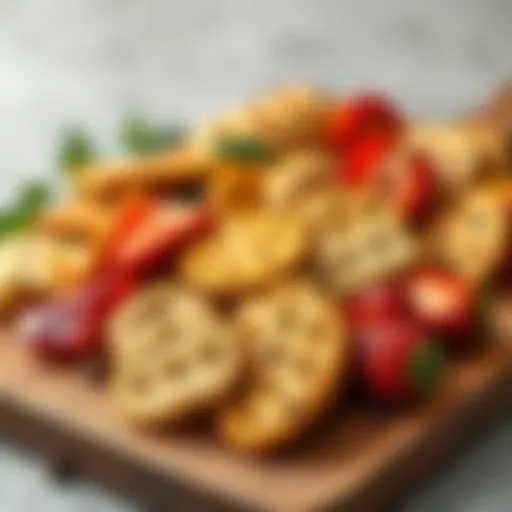Best Passover Dinner Recipes for Memorable Meals
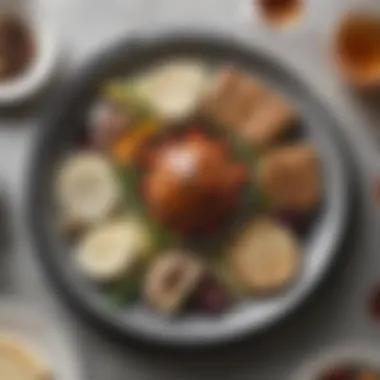
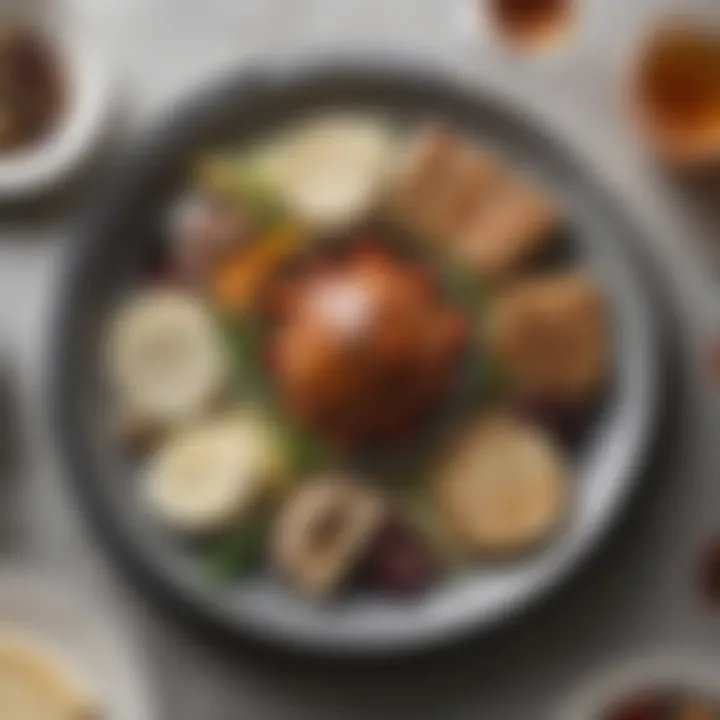
Intro
Passover is a significant festival in the Jewish calendar, celebrating the liberation of the Israelites from Egyptian slavery. This event is commemorated with a special meal known as the Seder, which revolves around specific foods that hold both historical and symbolic meaning. Every dish served plays a role in telling the story of this exodus. As people gather for this important occasion, the food they share becomes a central part of the tradition.
This article aims to explore various recipies for Passover dinner, emphasizing the balance of honoring time-honored customs while also adapting to modern palates. We will look into classics like matzo ball soup and brisket, as well as innovative vegetarian and gluten-free options that cater to diverse dietary needs. Each dish represents not just nourishment, but a connection to cultural heritage and familial bonds.
The following sections will dive into specific recipes, detailing ingredients, preparation methods, and any special notes that may enhance the cooking experience. Our goal is to encapsulate the essence of Passover dining, ensuring that every meal is flavorful, respectful of tradition, and a delight to share among family and friends.
Prologue to Passover Dinner
Passover dinner is a significant cultural and religious observance for Jews worldwide. It serves not only as a meal but as a reminder of historical events that shaped Jewish identity. The act of gathering around the table for this special dinner brings families and friends together, creating an intimate atmosphere of reflection, sharing, and remembrance.
Historical Context
The origins of Passover date back to the biblical narrative in the Book of Exodus, where the Israelites escaped from slavery in Egypt. This story is central to the Passover Seder, a ceremonial dinner that includes reading the Haggadah, which recounts the tale of liberation. During the Seder, each food item on the plate symbolizes various elements of this story, anchoring the meal firmly in cultural history.
The preparation for Passover often includes a thorough cleaning of the home to remove any leavened bread, which cannot be consumed during this time. This practice highlights the themes of purification and renewal that are pivotal to the Passover experience. The historical significance of this dinner goes beyond mere tradition; it embodies resilience and continuity within the Jewish community.
Significance of Traditional Foods
Food plays a crucial role in the Passover celebration. Each dish carries deep meanings and specific symbolism. For instance, matzo, the unleavened bread, represents the haste with which the Israelites fled Egypt. Charoset, a mixture of fruits and nuts, symbolizes the mortar used in brick-making by the slaves. By incorporating these traditional foods into the dinner, participants connect with their heritage and honor the struggles of their forebearers.
Moreover, sharing these dishes often fosters a sense of unity among family members. The act of passing around food encourages conversation about personal and communal histories, enriching the dinner experience.
Contemporary Passover Celebrations
In modern times, Passover celebrations have evolved while retaining their core essence. Many Jewish families now embrace contemporary interpretations of traditional recipes, infusing them with modern ingredients and cooking styles. This willingness to adapt allows for a richer culinary experience, providing options for various dietary needs, including vegetarian and gluten-free choices.
Additionally, the prominence of social media adds a new layer of sharing during Passover. From blogs to Instagram posts, families showcase their unique approaches to the meal, encouraging broader conversations and exchanges about Passover traditions. Such contemporary practices make Passover more accessible and engaging to younger generations, ensuring that the importance of this dinner is not lost over time.
Essential Ingredients for Passover
When it comes to Passover dinner, the ingredients used are the backbone of both flavor and tradition. This section highlights essential components that not only comply with dietary laws but also reflect the cultural significance of the holiday. Understanding these ingredients allows for an informed selection when planning meals that resonate with family heritage and contemporary culinary preferences.
Matzo Variations
Matzo is often called the bread of affliction, representing the haste with which the Jewish people left Egypt. Yet, it is also a versatile ingredient. There are several variations that one can incorporate into dishes.
- Traditional Matzo: Simply an unleavened flatbread, suitable for an endless list of applications from the classic matzo ball to desserts.
- Matzo Meal: Ground matzo that functions as a flour substitute. Enhance recipes like matzo ball soup or fritters.
- Flavored Matzo: Some brands offer matzo baked with herbs or spices, providing additional taste dimensions without compromising on tradition.
Using matzo variations can elevate a dish while maintaining the integrity expected during Passover.
Herbs and Spices
Herbs and spices are crucial for enriching dishes, allowing for creativity without losing connection to Passover customs. These small additions can transform simple ingredients into flavorful experiences.
- Parsley: This green herb is often used in Charoset, adding a touch of freshness that complements sweet flavors.
- Cinnamon: Frequently featured in desserts, cinnamon can also enhance savory dishes, bringing warmth to the meal.
- Garlic and Onion: Essential aromatics, they form the base for many Passover recipes, providing depth and richness.
Optimal use of herbs and spices will not only satisfy the palate but also imbue recipes with a sense of historical relevance.
Fruits and Vegetables
In celebrating Passover, incorporating fruits and vegetables frequently symbolizes renewal and abundance. These ingredients not only provide vibrant colors and flavors but also represent the satisfaction of agricultural bounty.
- Bitter Herbs: Such as horseradish or romaine lettuce, these are mandated elements in the Seder plate, offering a poignant reminder of slavery.
- Seasonal Vegetables: Spring vegetables like asparagus and artichokes are in season during Passover, allowing their freshness to be a central element of the meal.
- Fruits: Apples, pears, and pomegranates not only add sweetness to dishes but also serve in Charoset, a dish indicative of both history and sweetness.
Fresh fruits and vegetables play a significant role in Passover meals, enhancing both nutritional value and culinary diversity.
In summary, the essential ingredients for Passover provide a rich tapestry of taste, symbolism, and tradition. Understanding their significance allows for a more enriching and meaningful meal experience.
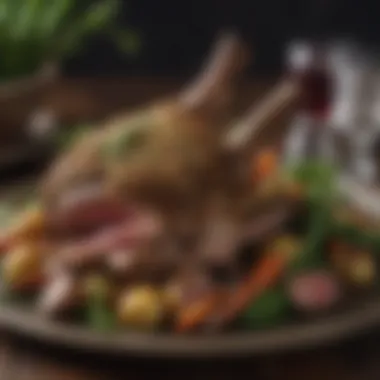
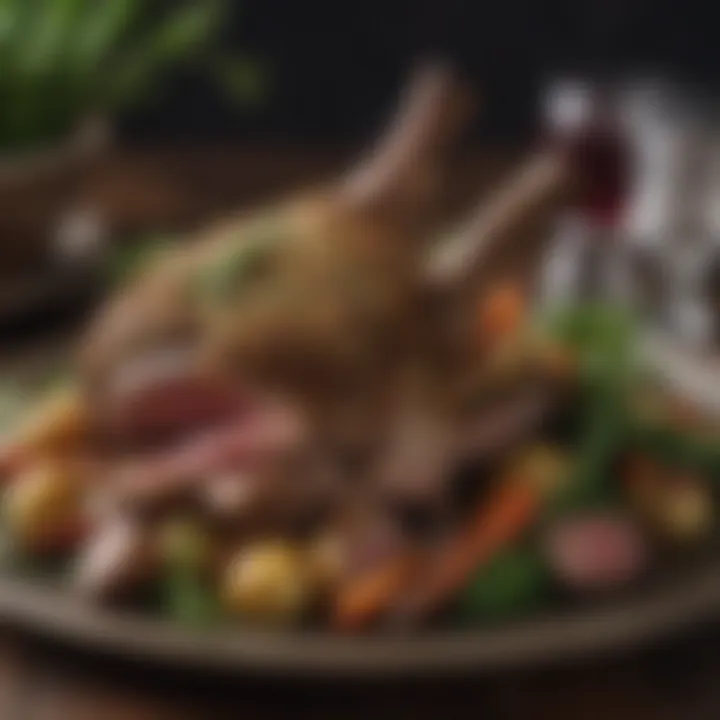
The intelligence in selecting these ingredients will reflect in the overall dining experience, marrying the old with the new, making each bite a story worth telling.
Appetizers That Set the Tone
Appetizers play a crucial role in setting the mood for a Passover dinner. They are often the first impression guests receive, and thus, their significance should not be underestimated. A well-selected array of appetizers can bridge the gap between traditional tastes and modern interpretations, making the meal both welcoming and memorable. Their function goes beyond mere sustenance; they can evoke memories and spark conversations. Providing a thoughtful variety of appetizers ensures that every guest feels included and excited about the meal ahead.
Charoset: A Symbol of Sweetness
Charoset is a staple on the Passover table, representing the mortar used by the Jews in their bondage in Egypt. This dish brings together various fruits, nuts, and wine, creating a sweet taste that contrasts with the bitterness of slavery. The mix can vary from Ashkenazi to Sephardic styles, leading to intriguing discussions around the table. Typical ingredients include apples, walnuts, and cinnamon, but variations can include pears and almonds for a unique twist.
The preparation is straightforward, making it an ideal first course. It is not only about flavor; presenting Charoset in an aesthetically pleasing way can enhance the dinner experience. A well-arranged bowl of Charoset can elicit curiosity and appreciation from guests, making them eager to learn more about its significance and flavors.
Matzo Ball Soup Innovations
Matzo ball soup is a classic offering during Passover. However, the soup can be innovated to cater to contemporary tastes. Traditional matzo balls are light and fluffy, but varying the ingredients can yield exciting results. Some may add herbs like dill or challenge tradition by infusing the broth with exotic spices. This not only elevates the flavor but also connects generations through shared culinary experiences.
For a modern twist, consider including a variety of proteins such as shredded chicken or even tofu for a vegetarian option. Each variation holds the potential to generate its own unique story, enhancing the dining experience. The process of making matzo ball soup can also be a family affair, drawing everyone into the preparation and sharing the experience that connects the past with the present.
Roasted Beet Salad
A roasted beet salad offers a colorful and nutritious complement to the appetizers, showcasing the richness of seasonal vegetables. Beets are naturally sweet and earthy, which pairs well with sharp feta or creamy goat cheese. The textural contrast between the soft beets and crunchy nuts enhances the overall appeal.
This salad can be enhanced with citrus dressing, which adds brightness and balances the flavors. Roasting the beets brings out their sweetness and deepens the flavor. Incorporating fresh herbs such as parsley or arugula adds layers of taste while also maintaining a fresh aspect essential for a successful Passover dinner.
Dishes like roasted beet salad are perfect for making each guest feel included, offering something they can enjoy regardless of dietary restrictions.
Incorporating these appetizers into the Passover dinner allows for a meal that is steeped in tradition while accommodating modern culinary preferences.
Main Course Selections
Main courses play a pivotal role in the Passover dinner experience. They not only reflect the rich history of the holiday but also resonate with personal tastes and culinary creativity. The significance of the main course is amplified by the fact that it often serves as the centerpiece of the meal. A well-prepared main dish can elevate the dining experience, enhance the festive atmosphere, and allow for family traditions to unfold.
The right selection of main courses also accommodates various dietary preferences, ensuring inclusivity for all guests. By offering diverse options, hosts can connect with their family’s culinary backgrounds while also introducing guests to fresh interpretations of traditional recipes.
Braised Brisket Recipe
Braised brisket is a classic dish that embodies the warmth of home and tradition. This recipe typically involves slow-cooking the meat in a flavorful broth until it reaches a tender, juicy state. The process of braising not only enhances the flavor but also allows for the melding of spices and herbs, resulting in a savory dish that captures the essence of Passover.
To prepare Braised Brisket, one might consider using quality cuts of meat such as the point cut for a more marbled texture. The following are key elements of this recipe:
- Ingredients: Brisket, onions, garlic, beef broth, tomato paste, and a blend of herbs such as thyme and bay leaves.
- Cooking Technique: Searing the brisket initially brings out deep flavors before adding liquids and herbs to gently braise.
- Flavor Profile: The final dish should have a balanced taste—rich, savory, and slightly sweet due to the caramelized onions.
Herb-Crusted Roast Chicken
Herb-Crusted Roast Chicken serves as an accessible yet impressive main course option for Passover. The preparation of this dish focuses on the use of fresh herbs, which can invigorate the usual roast chicken with layers of flavor and aromatic qualities.
Key highlights of the Herb-Crusted Roast Chicken include:
- Ingredients: Whole chicken, a variety of fresh herbs like rosemary, thyme, and parsley, olive oil, and lemon.
- Cooking Method: The chicken is coated with a mixture of chopped herbs and olive oil, then roasted at a high temperature to achieve a crispy skin while keeping the meat moist.
- Serving Suggestions: Pair with root vegetables or a seasonal salad for a well-rounded meal.
Stuffed Cabbage Rolls
Stuffed Cabbage Rolls are a comforting dish that harkens back to many family traditions. This dish combines ground meat, rice, and spices rolled in tender cabbage leaves, simmered in a tangy tomato sauce. The cabbage provides a unique texture, and it is both filling and nutritious.
The elements of preparing Stuffed Cabbage Rolls include:
- Fillings: Ground beef or turkey, cooked rice, onions, and herbs such as dill and parsley mixed together.
- Preparation Process: The cabbage leaves are blanched to soften them, making rolling easier. The filling is placed in each leaf and rolled up tightly to seal in flavors.
- Cooking Technique: The rolls are arranged in a pot, topped with sauce, and slow-cooked to allow the flavors to blend beautifully.
Each of these main course selections offers a unique touch to the table, enabling a thoughtful culinary experience on Passover. Choosing the right main course reflects care and respect for tradition, while also celebrating modern interpretations of these time-honored dishes.


Vegetarian and Vegan Options
In recent years, the shift towards plant-based diets has significantly influenced many culinary traditions, including Passover. Vegetarian and vegan options are becoming more prominent in Passover celebrations, catering not only to those who follow these diets but also to those looking for lighter and healthier meal alternatives. Offering vegetarian and vegan dishes can add depth to the Passover dinner, providing diverse flavors and textures that complement traditional recipes. It also honors the spirit of inclusivity, as these options can accommodate various dietary needs and preferences.
Quinoa and Vegetable Pilaf
Quinoa and vegetable pilaf is a delightful dish that showcases the versatility of quinoa, a superfood that is both nutritious and satisfying. This dish pairs the nutty flavor of quinoa with a medley of colorful vegetables. The cooking process is straightforward: first, rinse the quinoa to remove its natural bitterness. Then, sauté onions, garlic, and carrots in olive oil, adding seasonal vegetables like zucchini or bell peppers. Finally, combine the cooked quinoa with the sautéed vegetables, season with salt, pepper, and fresh herbs such as parsley or dill for a fresh touch. This dish not only looks appealing but is also high in protein and fiber, making it a wholesome choice.
Eggplant Parmesan with a Twist
Eggplant Parmesan is a beloved dish, and giving it a vegan twist can satisfy both longtime lovers and newcomers to this classic. Start by slicing eggplants and sprinkling them with salt to draw out moisture. After letting them sit, rinse and dry thoroughly, which helps reduce bitterness. Next, coat the eggplant slices in a mixture of whole wheat breadcrumbs and nutritional yeast to add a cheesy flavor without dairy. Bake the eggplant until it is golden and crispy. Layer the baked eggplant with marinara sauce and vegan cheese, then bake until heated through. This dish is hearty and indulgent, perfect for a festive dinner while remaining plant-based.
Roasted Vegetable Casserole
Roasted vegetable casserole is a flavorful and hearty option that can easily be adapted for Passover. Begin by selecting a variety of seasonal vegetables such as sweet potatoes, carrots, and broccoli. Cut the vegetables into uniform pieces and toss them with olive oil, garlic, and herbs. Arrange the vegetables in a baking dish and roast them until tender and caramelized. To enhance the dish, consider adding a layer of matzo crumbs on top for a satisfying crunch. The result is a colorful and nutritious side dish that pairs well with any main course, making it a perfect addition to a Passover dinner.
"Embracing vegetarian and vegan options not only enriches the Passover meal but also reflects a modern understanding of diverse dietary needs."
Side Dishes to Complement
Side dishes play a vital role in enhancing the overall dining experience during Passover. They not only add flavor to the main course but also contribute to the visual appeal of a meal. Notably, these dishes should respect the culinary guidelines of Passover while catering to diverse palates. The right side dishes can elevate a simple meal, making it festive and conducive to conversation around the table.
When selecting side dishes, consider how they align with the main offerings and any dietary restrictions of your guests. The best side items complement the flavors of the main course while offering a balance of textures. They can act as both contrast and support to the primary ingredients, offering variety in taste and visual elements.
Potato Kugel
Potato Kugel is a traditional Jewish dish made primarily from grated potatoes, onions, and eggs. This dish is often baked until crispy on the outside while remaining soft and fluffy on the inside. It serves as an excellent side dish due to its versatility and ability to pair with both meat and vegetarian main courses.
One significant benefit of Potato Kugel is its adaptability. You can customize it by adding spices, vegetables, or even different types of potatoes. For a unique twist, consider mixing sweet potatoes into the batter for a subtly sweet flavor that contrasts nicely with savory items. When serving, it can be cut into squares or wedges, making it easy for guests to help themselves.
Grilled Asparagus with Lemon
Grilled Asparagus with Lemon is a fresh and vibrant side dish that adds a touch of brightness to the Passover table. The preparation is simple: asparagus is lightly seasoned with olive oil and lemon juice before being grilled to perfection. This dish brings a crispness that can balance richer main courses like braised brisket.
Asparagus is also a nutrient-rich vegetable, providing vitamins and minerals essential for a well-rounded meal. The lemon adds not only flavor but also a zest that enhances the earthy tones of the asparagus. This dish is not only a good choice for Passover but is also suitable for those following a vegan or gluten-free lifestyle, making it inclusive for all guests.
Carrot Tzimmes
Carrot Tzimmes is a sweet carrot stew traditionally served during the Jewish holidays. With its base of carrots, sweetened often by honey or brown sugar, this dish encapsulates the spirit of Passover, focusing on sweetness as a symbol of joy and hope.
Tzimmes can include other ingredients like dried fruits or even sweet potatoes. This added depth of flavor makes it a perfect accompaniment to savory dishes. Additionally, the bright orange color of the carrots adds an appealing visual element to your dinner plate. Cooked slowly, Tzimmes allows the flavors to meld beautifully, creating a comforting dish that is sure to please many.
"In Jewish tradition, sweet dishes like Tzimmes symbolize the hope for a sweet and fruitful year ahead."
Desserts Worth Celebrating
Desserts hold a special place within Passover traditions. They symbolize sweetness and the joy that comes with the holiday. The act of breaking matzo and the retelling of the Exodus story are made complete with vibrant and flavorful desserts. These dishes not only offer a satisfying conclusion to the meal but also provide an opportunity to experiment with flavors and textures that can accommodate various dietary needs. This section will delve into three standout dessert options: Flourless Chocolate Cake, Coconut Macaroons, and Fruit Compote. Each recipe is designed to fulfill both the celebratory nature of Passover and the modern palate.
Flourless Chocolate Cake
The Flourless Chocolate Cake is a rich and dense dessert that captivates chocolate lovers. Its ingredients mainly consist of dark chocolate, butter, eggs, and sugar. The absence of flour allows for a gluten-free option, making it suitable for those adhering to Passover dietary restrictions.
To create this indulgent cake, start by melting the chocolate and butter together, mixing them until smooth. Next, beat the eggs and sugar until light and fluffy, then gently fold the chocolate mixture into the egg mixture. Pour the batter into a prepared pan and bake until set.
This cake is not only simple to prepare, but it also offers deep flavors that satisfy any dessert connoisseur. A dusting of cocoa powder or a dollop of whipped cream can elevate the presentation, making it a standout option for any Passover table.
Coconut Macaroons
Coconut Macaroons are another delightful addition to the dessert lineup. They have a chewy texture and a tropical flavor that contrasts nicely with heavier dishes often found at a Passover dinner. The key ingredients include shredded coconut, condensed milk, and egg whites.
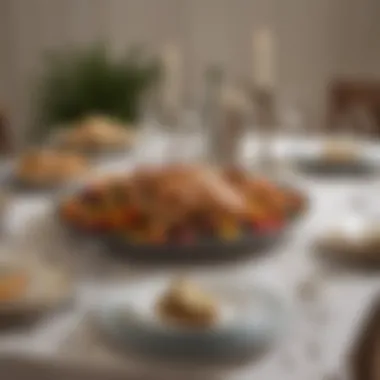

To prepare, combine the shredded coconut with the condensed milk and lightly beaten egg whites. Scoop the mixture onto a baking sheet and bake until golden brown.
These sweet bites are easy to transport and bake, making them an excellent treat to share. They provide a taste of an exotic sweetness while still being suitable for Passover observances. Variations can include dipping them in dark chocolate for added richness.
Fruit Compote
For a lighter dessert option, Fruit Compote offers a fresh and flavorful way to end the meal. It can be made from any combination of fruits, such as berries, apples, or pears, mixed with a little sugar and cooked until tender. Spices like cinnamon or nutmeg can be added for an aromatic touch.
Preparing the compote is straightforward: simply dice the fruits and combine them in a saucepan with sugar and spices. Cook over low heat until the fruits break down slightly. This dessert not only looks appealing but also provides bursts of flavor that cleanse the palate after a hearty meal.
In essence, desserts are essential to celebrating Passover. They complete the meal and allow for creativity in presentation and flavor. Each dessert in this section brings unique textures and tastes, contributing to a festive atmosphere.
Tips for a Successful Passover Dinner
Planning a Passover dinner goes beyond simply preparing food. It involves thoughtful consideration of tradition and creativity. A successful Passover dinner requires attention to various factors like menu planning, timing, and ambiance. Each aspect plays a crucial role in creating an experience that resonates with both the meaning of Passover and the preferences of your guests. In this section, we will explore these elements in detail, aiming for a dinner that is memorable and satisfying for all.
Planning the Menu
The menu serves as the foundation for your Passover dinner. Start by considering traditional dishes that honor the holiday. Classic selections include brisket, matzo ball soup, and charoset. However, it is also vital to incorporate modern twists or dietary preferences, such as vegan or gluten-free options.
When planning:
- Identify staple dishes that guests expect.
- Consider variations or adaptations that add unique flavors.
- Balance the menu with appetizers, main courses, side dishes, and desserts.
While planning, also think about the number of guests and their dietary restrictions. Communicating with guests ahead of time can provide valuable insights into preferences and allergies. A harmonious blend of traditional and contemporary dishes can create a dynamic menu.
Timing and Preparation
Timing is essential for the smooth execution of your Passover dinner. Start by mapping out a timeline that incorporates each dish’s preparation and cooking times.
Begin with these key points:
- Grocery shopping: List going to ensure nothing is forgotten.
- Preparation periods: Consider which dishes can be made in advance and frozen, allowing you to focus on fresh items as the dinner approaches.
- Cooking day: Plan to start early. Aim for a specific start time to cue when each dish should be prepped.
Aim to allocate ample time for unexpected delays. The goal is to serve hot food while minimizing stress. An organized kitchen contributes significantly to the overall experience of the evening.
Setting the Table and Atmosphere
Creating an inviting atmosphere can elevate the Passover dinner experience. The table should reflect the holiday’s significance and set the tone for the meal. Here are some elements to consider:
- Tablecloth and Dinnerware: Use traditional table settings that include matzo plates, wine glasses, and Seder plates if applicable.
- Centerpieces: Consider using flowers or symbolic items that resonate with the celebration.
- Lighting: Warm lighting can create a welcoming environment. Avoid stark, bright lights that might feel uninviting.
Don’t forget about the importance of music. Soft background tunes can enhance the ambience without overpowering conversation.
Closure and Final Thoughts
In concluding this exploration of Passover dinner recipes, it is essential to recognize the balance between honoring tradition and integrating modern culinary practices. This approach not only enhances the dining experience but also makes cultural observance more relatable for varying audiences. Each element discussed—from essential ingredients to thoughtful menu planning—plays a critical role in shaping memorable celebrations.
Embracing Tradition and Innovation
The essence of any Passover dinner lies deeply rooted in tradition. Recipes have been passed down through generations, bearing stories and significance that form the core of the celebration. Yet, there is undeniable value in innovation. By introducing contemporary spins on classic dishes, one can appeal to diverse palates. For instance, while matzo ball soup is a cherished staple, experimenting with flavors such as lemongrass or spinach can breathe new life into this age-old comfort food. Such duality enriches the experience, allowing families to enjoy authenticity while also engaging with broader culinary trends.
- Traditions preserved: Classic recipes hold emotional value and cultural heritage, educating younger generations.
- Innovation embraced: Creative variations cater to modern dietary preferences, including vegan or gluten-free options.
In this context, every family can customize their menu to reflect both personal tastes and traditional values. The act of cooking and sharing these meals fosters connection and continuity, making the dining experience both personal and collective.
Looking Forward to Future Celebrations
As we look ahead to future Passover gatherings, the culinary landscape continues to evolve. With a focus on sustainability and ethical food sourcing, upcoming celebrations can incorporate practices that respect the environment while honoring tradition. This shift may include local produce, organic ingredients, and even a return to simpler cooking techniques that highlight freshness and authenticity.
Moreover, as global cultures intertwine, there is an opportunity to blend flavors and recipes from various backgrounds, enriching the Passover experience further. This can be achieved by introducing new dishes that complement traditional ones, creating a diverse table that reflects the modern, multicultural society we live in.
“Embracing cultural diversity in our celebrations can lead to enriched experiences and a deeper understanding of community.”
Ultimately, as families gather around the table for Passover, they can do so with a renewed appreciation for both the past and the future of their culinary heritage. This dynamic approach elevates the dinner experience, making it not only a feast for the senses but also for the soul.



